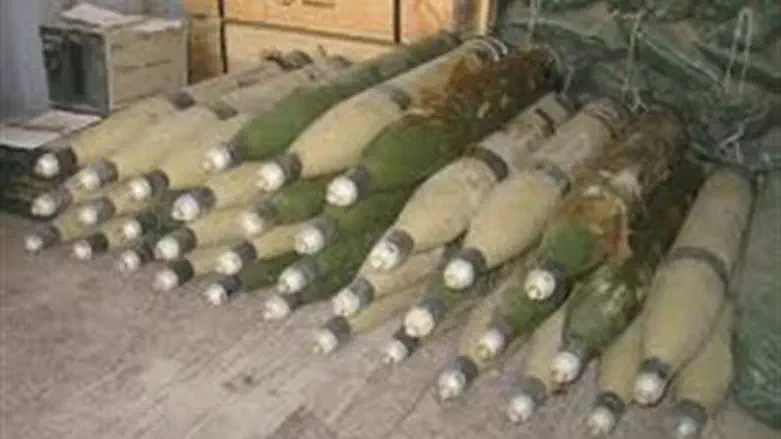
Tuesday’s seizure of made-in-Iran weapons shipped from Syria for Hamas-controlled Gaza is the latest in a long list of illegal attempts by the Iran-Syria-Hizbullah-Hamas axis of evil to use the high seas to smuggle arms for attacking Israel.
November 3, 2009: The Francop ship was intercepted off the coast of Cyprus en route from Iran to Syria where its weapons were to be smuggled by land to Hizbullah in Lebanon.

The ship contained 36 containers with:
- 500 tons of arms: 9,000 mortar bombs;
- 3,000 Katyusha rockets;
- 3,000 gun shells;
- 20,000 grenades; and
- half a million rounds of small ammunition, all hidden behind sacks of polyethelene.
The arms smuggling was attempted without the knowledge of the crew. The cache was loaded from the Bandar Port in Iran on an Iranian vessel and stopped at an Egyptian port, where the cache was unloaded onto the Francop, a German vessel. The cache was 10 times larger than the cache seized from the Karin A in 2002 (see below).
October 12, 2009: The Hansa India, which sailed from Iran flying a German flag, was due to unload a cargo of eight containers in Egypt. Following warnings from the German authorities, the vessel was not unloaded and continued to Malta where it was seized and found to be carrying bullets and industrial material intended for the production of weapons, seemingly bound for Syria.
May 21, 2003: The Abu Hasan was intercepted in waters west of Haifa, sailing from Lebanon to Egypt and carrying Hizbullah explosives bound for Gaza. The boat itself was a fishing boat, undoubtedly used to disguise its intentions. Cargo contained:
- a radio-activation system to detonate bombs remotely;
- CDs of directives on how to carry out suicide bomb terror attacks;
- five boxes with rocket fuses; and
- 25 Katyusha rocket detonators.
The masterminds of the arms smuggling attempt were connected to Arafat's Palestinian Authority and Hizbullah.
January 7, 2003: A suspicious life raft found floating along the northern Gaza Strip coast was found to be booby-trapped with explosives.
November 23, 2002: After many attempts to communicate with an unknown Arab fishing boat heading from Gaza northward to Israel’s coast, the bomb-laden boat exploded near an Israeli security patrol boat, moderately injuring three and lightly injuring one.
August 4, 2002: IDF naval forces identified an armed Arab terrorist wearing an oxygenated scuba diving suit and carrying an AK-47 assault rifle, eight grenades, and four ammunition magazines. He was on his way towards an Israeli community from the Gaza coast.
June 8, 2002: Two Arabs were found swimming along the north Gaza Strip shore armed with four grenades, an AK-47, and four ammunition magazines in an attempt to infiltrate an Israeli community.
January 3, 2002: Karin-A was intercepted in the Red Sea, heading towards the Palestinian Authority. It carried 80 submergible containers of 50 tons of weapons, including:
- RPG-7 rockets;
- RPG-18 anti-tank rocket launchers;
- Iranian-made anti-tank and anti-personnel mines;
- 2200 kilograms of high explosive demolition blocks;
- Sagger anti-tank launchers and missiles;
- Rifles, including AK-47 assault rifles, and machine guns;
- 735 hand grenades;
- 700,000 rounds of small ammunition; and
- diving equipment.
The submergible containers were to be dropped into the sea and then washed ashore the Gaza coast or picked up by a smaller vessel and delivered to Gaza.
Yasser Arafat's former confidante at the time, Fuad Shubaki, was heavily involved in the smuggling attempt, and the crew included members of the Palestinian Authority. Arafat eventually admitted PA involvement in the smuggling attempt. The ship was purchased in Lebanon and sailed to Sudan and Yemen to pick up civilian goods – watermelon seeds, sesame seeds, rice, toys and clothes – to disguise the weapons aboard.

May 7, 2001: The Santorini was intercepted on its way from Lebanon to Gaza. It contained a large shipment of 40 tons of weapons, including Strela anti-aircraft missiles – the same kind that terrorists fired at an Arkia Israeli passenger jet taking off from Mombassa, Kenya in November 2002, and narrowly missed. The shipment also included mortars, rifles and guns, grenades, mines and explosive material, anti-tank RPG-7 missile-launchers, and artillery rockets.
Three crew members aboard the Santorini were convicted for trying to smuggle weapons from Lebanon to Gaza – the captain, a professional weapons smuggler, and two of his relatives aboard the ships and involved in three previous smuggling attempts backed by Hizbullah and the PFLP-GC terrorist groups.
The Santorini ship was acquired by PFLP-GC on a small island off Syria and registered as Syrian. During previous smuggling attempts by the crew, arms were packed in Syria and transferred to Lebanon by a Syrian bus. Part of the anti-tank weaponry originated in Iran.